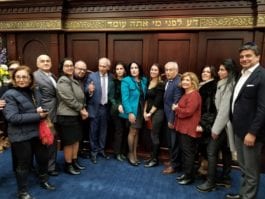When the Persian Jews fled to the United States 40 years ago amidst the Iranian Revolution, it was often with a suitcase and a question of when they would return home.
“Yes, they lived here,” professor Saba Soomekh said, “but they didn’t mentally feel like they belonged here.”
Today, Soomekh said, the community has started becoming more civically involved and the suitcase mentality is gone.
Soomekh’s comments about the changes in how Persian Jews view their place in this country were part of a talk about this past, the present and future of the Persian Jewish community in the United States before a diverse crowd at Beth Hadassah synagogue in Great Neck on Monday night.
Included was an exploration of issues of identity and culture among a group now here to stay.
Soomekh, the associate director of UCLA’s Alan D. Leve Center for Jewish studies, drew upon several years of research in Los Angeles, as well as her own personal experience, as her family fled Iran to escape the Islamic Revolution in the late 1970s.
Soomekh said that in the early days, many Persian Jews who fled Iran lived with a “suitcase mentality” – as in, they believed someday they may be able to go back home – and have a very insular culture. Consequently, acculturation has been delayed.
But today, at least in the case of Persian Jews in Los Angeles, many still wrangle with issues of trauma stemming from upending their lives in one day, as well as a sort of “identity crisis” over how much of the culture to pass on – and whether or not it can survive.
“It really is the American story of immigrants coming, and assimilation, and in the how much are you Jewish, how much are you from the old country,” Soomekh said.
The younger generation also sees unique issues, Soomekh said, such as daughters sometimes acting as “therapists” for their mothers and sons feeling the pressure to be immediately financially successful and be able to provide for a family.
There are also some taboos that the community, which has historically been reluctant to ask for help, is trying to address such as drug abuse and depression, Soomekh said.
Soomekh also addressed numerous questions, including one on the future of the Persian Jewish community and whether or not the Persian Jewish community would distinctly identify as such by 2100.
Soomekh said she believes that, based on the last 40 years of tightness since fleeing the Iranian Revolution, that 80 years from now the Persian Jewish community will still be distinct.
She also made a case for continuing both the Jewish and uniquely Persian parts of the culture, whether it was the poetic parts, family Shabbats, and learning the native language of Farsi.
“Iranian Jews get criticized for being insular and there’s a lot of criticism that’s fair about that,” Soomekh said. “But again, that insularity has kept the community together.”
The younger generation also needs to be taught the history, she added.

Rebecca Sassouni, the current president of Sephardic Heritage Alliance Inc., which sponsored the event, said the reaction of the audience was telling. Sassouni said it shows that the community appears “deeply interested” in learning about what their future in America will look like.
“Her remarks were extremely resonant,” Sassouni said.
Raymond Eshaghoff, the past president of SHAI and a current board member, said that he saw a lot of similarities between the Persian Jewish communities in Los Angeles and Great Neck, including the issues they’re hoping to overcome.
“We’re always looking to challenge the community to talk about difficult subjects and look for history to find some clues to our future,” Eshaghoff said. “And I think professor Saba Soomekh was extremely knowledgeable of the Persian Jewish community and was able to shed some light on some of the difficult subjects that we need to talk about within the community.”
Temple Israel Rabbi Daniel Schweber said that he came out because his congregation has a significant Perisan population and he wanted to “continue to learn,” be a part of their community, and find ways to celebrate their differences.
Schweber said it was very interesting to see how three generations experienced Iran very differently, as well as “just how caring and eager they are to preserve their culture and to live here in the U.S.”
“I thought it was wonderful,” Schweber said of the event.
Anyone interested in watching the full presentation can watch in online at shaiusa.org, as well as a previous presentation by Sassouni on the Persian Jewish community specifically in Great Neck.



